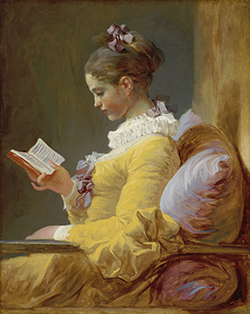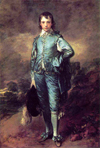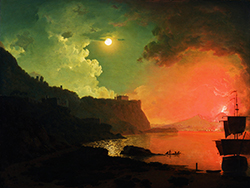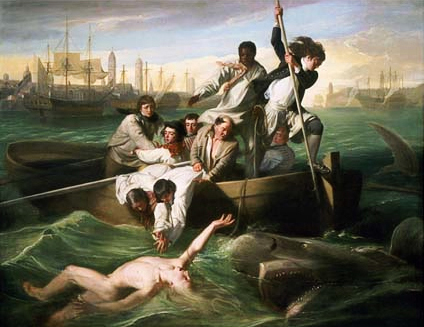MENU
The Electronic Scholarly Publishing Project: Providing access to classic scientific papers and other scholarly materials, since 1993. More About: ESP | OUR CONTENT | THIS WEBSITE | WHAT'S NEW | WHAT'S HOT
Comparative Timelines
The ESP Timeline (one of the site's most popular features) has been completely updated to allow the user to select (using the timeline controls above each column) different topics for the left and right sides of the display.
Select:
New Left Column
New Left Column
Dates
Decade
New Right Column
New Right Column
Erasmus Darwin has the allegorical motto E conchis omnia or "Everything from shells" painted on his carriage, promoting the idea of common descent. Bowing to social pressure, he removes it shortly thereafter.
1770
 Painting by Jean-Honor Fragonard: Young Girl Reading, or The Reader (French: La Liseuse), is an 18th-century oil painting, purchased by the National Gallery of Art in Washington, DC in 1961 using funds donated by Ailsa Mellon Bruce, the daughter of Andrew W. Mellon, following her father's death. The work is more a genre painting of an everyday scene than a portrait, and the name of the sitter is not known. X-ray photography has revealed that the canvas originally featured a different head looking towards the viewer, which Fragonard painted over.
Painting by Jean-Honor Fragonard: Young Girl Reading, or The Reader (French: La Liseuse), is an 18th-century oil painting, purchased by the National Gallery of Art in Washington, DC in 1961 using funds donated by Ailsa Mellon Bruce, the daughter of Andrew W. Mellon, following her father's death. The work is more a genre painting of an everyday scene than a portrait, and the name of the sitter is not known. X-ray photography has revealed that the canvas originally featured a different head looking towards the viewer, which Fragonard painted over.
 Painting by Thomas Gainsborough: The Blue Boy. Perhaps Gainsborough's most famous work, it is thought to be a portrait of Jonathan Buttall (1752 1805), the son of a wealthy hardware merchant, although this has never been proven. It is a historical costume study as well as a portrait: the youth in his 17th-century apparel is regarded as Gainsborough's homage to Anthony van Dyck, and in particular is very close to Van Dyck's portrait of Charles II as a boy.
Painting by Thomas Gainsborough: The Blue Boy. Perhaps Gainsborough's most famous work, it is thought to be a portrait of Jonathan Buttall (1752 1805), the son of a wealthy hardware merchant, although this has never been proven. It is a historical costume study as well as a portrait: the youth in his 17th-century apparel is regarded as Gainsborough's homage to Anthony van Dyck, and in particular is very close to Van Dyck's portrait of Charles II as a boy.
In Gailenreuth Cave in Germany, Father Johann Esper finds human bones underlying those of extinct animals. He concludes that the bones got there by accident, an opinion Cuvier will share.
 Italian anatomist Luigi Galvani discovers accidentally the action of electricity on the muscles of the dissected frog: it causes a twitch.
Italian anatomist Luigi Galvani discovers accidentally the action of electricity on the muscles of the dissected frog: it causes a twitch.
Joseph Priestly discovers that a plant can produce enough breathable air to sustain a mouse and keep a candle burning. Though he describes it in different terms, he has discovered oxygen.
1771
(no entry for this year)
(no entry for this year)
1772
(no entry for this year)
(no entry for this year)
1773
(no entry for this year)
(no entry for this year)
1774
(no entry for this year)
 Franz Anton Mesmer suggests that "animal magnetism" causes attractions between certain persons. Mesmer's name becomes the root of the English verb "mesmerize".
Franz Anton Mesmer suggests that "animal magnetism" causes attractions between certain persons. Mesmer's name becomes the root of the English verb "mesmerize".
 Johann Christian Fabricius's Systema Entomologiae classifies insects based on the structure of mouth organs rather than wings.
Johann Christian Fabricius's Systema Entomologiae classifies insects based on the structure of mouth organs rather than wings.
1775
(no entry for this year)
Abbé Jacques-François Dicquemare describes reptilian fossils in Journal de Physique but refrains from speculating about their sources.
1776
 Painting by Joseph Wright: Vesuvius in Eruption is the subject of thirty paintings and at least one preliminary sketch by Joseph Wright of Derby, who travelled in Italy in the years 1773-1775. It appears that whilst Wright was in Italy Vesuvius was not erupting.
Painting by Joseph Wright: Vesuvius in Eruption is the subject of thirty paintings and at least one preliminary sketch by Joseph Wright of Derby, who travelled in Italy in the years 1773-1775. It appears that whilst Wright was in Italy Vesuvius was not erupting.
(no entry for this year)
1777
(no entry for this year)
(no entry for this year)
1778
 Painting by John Singleton Copley: Watson and the Shark about a shark attack on a swimmer, Brook Watson, that occurred in Havana, Cuba in 1749. Copley had never visited Havana, and it is likely that he had never seen a shark, much less a shark attack. It is probable that he gleaned details of Havana harbor from prints and book illustrations: he includes the real landmark of Morro Castle in the background of the painting. The shark is less convincing; it includes details not found in sharks, such as forward-facing eyes and lips.
Painting by John Singleton Copley: Watson and the Shark about a shark attack on a swimmer, Brook Watson, that occurred in Havana, Cuba in 1749. Copley had never visited Havana, and it is likely that he had never seen a shark, much less a shark attack. It is probable that he gleaned details of Havana harbor from prints and book illustrations: he includes the real landmark of Morro Castle in the background of the painting. The shark is less convincing; it includes details not found in sharks, such as forward-facing eyes and lips.
 Jan Ingenhousz discovers two distinct respiratory cycles in plants: at night oxygen is absorbed and carbon dioxide is exhaled; during the day carbon dioxide is absorbed and oxygen is exhaled. The exact nature of the exhaled gases becomes clear with the later discoveries by Lavoisier.
Jan Ingenhousz discovers two distinct respiratory cycles in plants: at night oxygen is absorbed and carbon dioxide is exhaled; during the day carbon dioxide is absorbed and oxygen is exhaled. The exact nature of the exhaled gases becomes clear with the later discoveries by Lavoisier.
Jan Ingenhousz discovers photosynthesis: In Experiments on Vegetables Ingenhousz shows that sunlight is essential for the production of oxygen by leaves.
The peculiar inheritance of human color-blindness reported to The Royal Society of London by Michael Lort.
 Lazzaro Spallanzani studies the role of semen in fertilization and learns that the sperm must make physical contact with the egg for fertilization to take place.
Lazzaro Spallanzani studies the role of semen in fertilization and learns that the sperm must make physical contact with the egg for fertilization to take place.
1779
(no entry for this year)
ESP Quick Facts
ESP Origins
In the early 1990's, Robert Robbins was a faculty member at Johns Hopkins, where he directed the informatics core of GDB — the human gene-mapping database of the international human genome project. To share papers with colleagues around the world, he set up a small paper-sharing section on his personal web page. This small project evolved into The Electronic Scholarly Publishing Project.
ESP Support
In 1995, Robbins became the VP/IT of the Fred Hutchinson Cancer Research Center in Seattle, WA. Soon after arriving in Seattle, Robbins secured funding, through the ELSI component of the US Human Genome Project, to create the original ESP.ORG web site, with the formal goal of providing free, world-wide access to the literature of classical genetics.
ESP Rationale
Although the methods of molecular biology can seem almost magical to the uninitiated, the original techniques of classical genetics are readily appreciated by one and all: cross individuals that differ in some inherited trait, collect all of the progeny, score their attributes, and propose mechanisms to explain the patterns of inheritance observed.
ESP Goal
In reading the early works of classical genetics, one is drawn, almost inexorably, into ever more complex models, until molecular explanations begin to seem both necessary and natural. At that point, the tools for understanding genome research are at hand. Assisting readers reach this point was the original goal of The Electronic Scholarly Publishing Project.
ESP Usage
Usage of the site grew rapidly and has remained high. Faculty began to use the site for their assigned readings. Other on-line publishers, ranging from The New York Times to Nature referenced ESP materials in their own publications. Nobel laureates (e.g., Joshua Lederberg) regularly used the site and even wrote to suggest changes and improvements.
ESP Content
When the site began, no journals were making their early content available in digital format. As a result, ESP was obliged to digitize classic literature before it could be made available. For many important papers — such as Mendel's original paper or the first genetic map — ESP had to produce entirely new typeset versions of the works, if they were to be available in a high-quality format.
ESP Help
Early support from the DOE component of the Human Genome Project was critically important for getting the ESP project on a firm foundation. Since that funding ended (nearly 20 years ago), the project has been operated as a purely volunteer effort. Anyone wishing to assist in these efforts should send an email to Robbins.
ESP Plans
With the development of methods for adding typeset side notes to PDF files, the ESP project now plans to add annotated versions of some classical papers to its holdings. We also plan to add new reference and pedagogical material. We have already started providing regularly updated, comprehensive bibliographies to the ESP.ORG site.
ESP Picks from Around the Web (updated 06 MAR 2017 )
Old Science

Weird Science

Treating Disease with Fecal Transplantation
Fossils of miniature humans (hobbits) discovered in Indonesia

Dinosaur tail, complete with feathers, found preserved in amber.
Astronomy

Mysterious fast radio burst (FRB) detected in the distant universe.